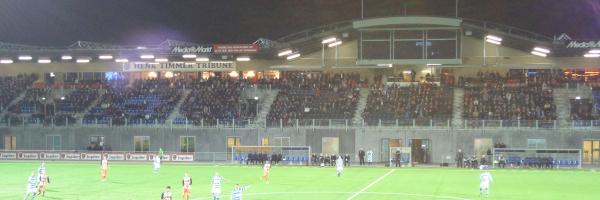
Last week, inbedwithmaradona.com enthusiastically pointed to the official website of small Dutch club FC Zwolle, more specifically to a virtual tour of the FC Zwolle Stadion. The tour leads you through the insides of the stadium’s main stand, covering everything from the dressing room, to the player’s home, storage room and control areas, and comes indeed highly recommended.
Now, the FC Zwolle Stadion, despite only being a few years old, actually has a pretty interesting history, and also serves as an example of how bad management of the construction of a new stadium can lead to, let’s say, “sub-optimal” outcomes.
FC Zwolle, currently leader in the Dutch second division (Eerste Divisie), has been a standard fixture in that league for years. In the last 15 seasons the club has consistently competed for promotion, ending 10 times in the top 5, but could never really make the jump to the Eredivisie, apart from a two season spell around 2002.
However, the club always showed a certain ambition to make the jump, and as early as the late 1990s recognised that a new stadium would be essential to survive at Eredivisie level, as their old Oosterenk Stadion had too many limitations in terms of capacity and sponsor facilities.
Building a new stadium is never an easy process, however the process for FC Zwolle turned out to be a particularly frustrating one. The plans fell victim to severe opposition from local political parties and citizens that objected against the costs involved. Once solved with the inclusion of a mega-supermarket, existing supermarket owners feared the increased competition and blocked the plans. The supermarket got replaced by a casino, but this led to opposition of religious groups who objected against gambling culture. Put up for a referendum, the conservative Zwolle citizens subsequently voted the plans down. And then there was the nearby windmill which would loose wind due to the increased height of the stadium.
By the mid-2000s the tide had finally turned, and plans were on the brink of getting approved. By then however, the club was in a big hurry to start construction, as it saw much of the competition already playing in new stadiums. Worsening results on the pitch, administrative chaos, and shrinking budgets did not help the situation.
Once the new stadium had been finished in 2009, many Zwolle fans realised that this was not the stadium they had dreamt of all this time, but that something had happened that many fans still dislike. You will likely spot this when you move to the pitch (veld) in the virtual tour. Or, in lesser quality, in the below photo (and the one above). It’s not the artificial turf, though also no fan’s favourite.

A typical feature of new Dutch stadiums in the late 1990s, led by the Amsterdam ArenA, was a ditch between pitch and stands. For safety reasons, so that fans could not enter the pitch (Holland had a big hooligan problem in the 90s), as a way to access the stands (with stairs), or to supply the stores that are often housed in new stadiums.
However, by the mid-2000s the hooligan problem had faded, and a trend had started to bring fans closer to the pitch to increase atmosphere, following the English model. This meant either lowering the stands to pitch level, or raising the field a (few) metre(s).
Zwolle’s stadium designs stemmed from the beginning of the century and had accounted for the traditional ditch, in this case particularly important to supply the stores, hence the doors you can see about every five metres. Due to the rush Zwolle was in to realise the stadium, designs were never properly revised, though still initially assumed a raised pitch. However when financials lacked, the club chose to install an artificial pitch and to save the costs of raising the pitch.
This in turn led to very visible grey concrete walls, not even that much inside the stadium, but especially on television, cutting the image off exactly where the stands start. This has given the stadium a soulless, impersonal reputation, even though attendances are far higher than the division’s average. Which is a a big frustration for the fans, who had preferred an English-style stadium with the stands close to the pitch.
Naturally the pitch can still be raised, however this involves significant costs that the club is not willing to make right now. Extension of the stands to pitch level would be another option (Zwolle fans enter the stadium through the stands), however these rows would have no cover and this would block store supply routes.
It therefore seems that the Zwolle fans will have to live with the stadium as imperfect as it is, and make the best of it with banners, something that has already been applied at the fanatics’ end. And when the club will reappear in the Eredivisie next season, national television audiences in turn will have to get adjusted to a small grey bar in the top of their screen.
